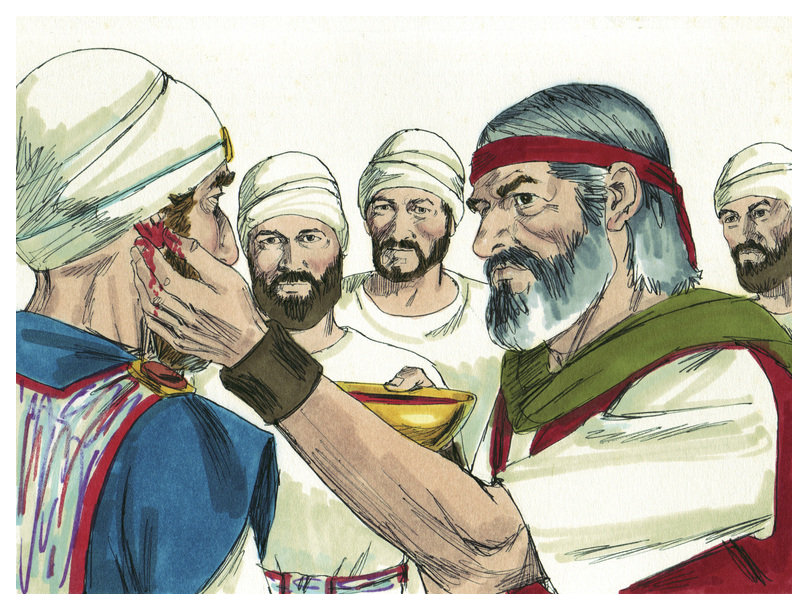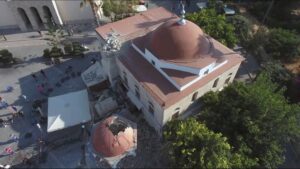
When the leper heals, he brings two live birds, cedar, crimson wool, and hyssop. The priest will slaughter one bird onto a clay vessel filled with fresh water. He will then dip the live bird, with the cedar, crimson wool, and hyssop, in the mixture of blood and water. He will sprinkle it on the healing leper seven times, and will then let the live bird fly into the fields. (Free translation of Lev. 14:2-7)
This strange ritual is usually understood as a symbolic act of atonement for the sin of gossip and calumny, which in turn is understood as the spiritual sin of the leper. The blood stains the water, just as the leper contaminated his environment, and setting the bird free symbolizes the far-reaching damage of the rumors spread by the leper. This explanation presents the healing process of the leper as incomplete, as its symbolism still carries an accusatory tone.
In addition, though the traditional view of leprosy as a punishment for calumny is supported by several verses, and seems to be the reason for the leprosy contracted by Moshe and Miriam, other cases mentioned in the bible do not fall under this category.
I would like to offer a broader definition to the spiritual sin punished by leprosy, based on the concept of the bi-radical root. This is the theory that in biblical Hebrew we can identify two-letter roots which later branch out to three-letter ones. All the new roots created are nuances of the original one[1]. The word צרעת – leprosy, is derived from the root צרע, which has in its basis the bi-radical root צר – narrow. That root is also in the basis of the biblical roots צרב, צרה, צרח, צרפ, צרר, which all share the concept of being limited or restricted. צרב means burning the skin, limiting its growth; to be in צרה is to be in a narrow place, in distress; צרח means a sharp, piercing scream, as well as a high and narrow tower; צרפ is the action of separating slags from metal, most commonly used in the bible as a metaphor for suffering; צרר is a bundle, which contains objects in an enclosure, and it also means adversaries, in the sense of those who besiege.
We can conclude, then, that the sin of the leper is a narrow and limited world view, which prevents him from unlocking potential talents and which leads him to misjudge others.
This definition explains the six known cases of leprosy in the bible, and includes the sins of gossip, arrogance and greed:
Moshe (Exodus 4:1-7): Moshe refuses to believe that the Israelites will be open to his offer of redemption. Despite God’s promise, he chooses to limit his vision. He is punished with momentary leprosy.
Miriam (Numbers 12:1-16): Miriam speaks against Moshe. She complains that she is as great a prophet as he is. Seeking the glory and greatness of others is a sign that one chooses to mimic them instead of searching for his own talents. Because of Miriam’s own greatness, her leprosy lasts only seven days, as if to show that her words were said at a moment of weakness.
Uziyahu (II Chronicles 26): Uzziyahu was one of the most successful kings of the southern kingdom of Yehudah, a conqueror, a builder, and a unifier, but at a certain point he wanted to serve as the High Priest. The priests tried to prevent him, but he forced his way to the inner sanctuary with frankincense, only to emerge with leprosy in his forehead, where the High Priests carried the band with God’s name on it. Uzziyahu’s sin was similar to that of Miriam in that he felt that he needed to mimic others and perform the duties of the High Priest in order to display his greatness. In reality, he did not need that because he had so many other qualities. Probably because the king’s transgression involved a physical conflict and a breach of the Temple’s boundaries, he remained a leper for life.
Naaman (II Kings 5:1-19): We are not told what was the cause for Naaman’s leprosy, but we do know that Naaman, who was an Aramean general, came to see Elisha after a long correspondence and an elaborate journey, in hope of being cured of his disease. Elisha ordered the general to bathe seven times in the Jordan river, to which he responded with anger: “I thought that he would raise his hand and cure me; did I travel all that distance to be told to bathe in this small river? My rivers back home in Damascus, Amana and Parpar, are better than all the waters of Israel! I can bathe in them and heal!” Naaman, who made the journey from Aram to Israel with the belief that the prophet could cure him, was willing to turn around and return home without heeding the prophet’s advice, because it did not make sense to him. That is the epitome of narrow-mindedness. Luckily for him, his servants proved to be more open-minded, and they convinced him to bathe in the Jordan, arguing that he has nothing to lose, and he was indeed cured.
Gehazi (II Kings 5:20-27): The grateful Naaman returns to Elisha and offers a generous reward, but the prophet declines to accept it and is satisfied with Naaman’s recognition of God’s power. Elisha’s servant Gehazi, who refuses to accept his master’s decision, chases the general’s chariot and tells him that his master changed his mind because he has just received poor visitors. When Gehazi returns home with his loot, Elisha tells him that Naaman’s leprosy will now afflict him. Gehazi’s actions stemmed from the narrow vision of one who thinks that material wealth is the solution to all his problems. He has become similar to the leper Naaman, in refusing to accept his master’s decision and thinking that he can deceive him.
Four anonymous lepers (II Kings 7:3-9): The lepers were sitting outside the gates of the besieged city of Shomron. When they found out that the enemy’s army was driven away miraculously, they moved from tent to tent, carrying loot and burying it in hiding places, eating and drinking. It was only after they had been doing it for a while that they remembered the plight of their brethren, who were suffering extreme hunger inside the city. Their initial actions show their narrow focus on themselves and on material needs.
In conclusion, we could say that the bible warns us of the dangers of not opening our mind and our heart to the possibilities surrounding us, and of trying to mimic others. This understanding sheds light on the strange ritual of the leper’s purification. Slaughtering the first bird over the water symbolizes the killing of innovation and creativity. The cedar and hyssop, the mightiest and lowliest plants, represent the wide range of possibilities, and the crimson stuff stands for human craftsmanship, which uses simple raw materials to create new and magnificent objects. The second bird is set free to send the message that instead of limiting ourselves, we should spread our wings and explore new fields.
The reward of open-mindedness is immense, as Mihaly Csikszentmihalyi, professor of psychology in the university of Chicago, writes in regard to what he defines as domains of knowledge (Creativity, p. 37):
The existence of domains is perhaps the best evidence of human creativity. The fact that calculus and Gregorian chant exist means that we can experience patterns of order that were not programmed into our genes by biological evolution. By learning the rules of a domain, we immediately step beyond the boundaries of biology and enter the realm of cultural evolution. Each domain expands the limitations of individuality and enlarges our sensitivity and ability to relate to the world. Each person is surrounded by an almost infinite number of domains that are potentially able to open up new powers to those who learn their rules.
These words, in a different phrasing, could have easily been taken out of a Kabbalistic text, and as we have seen here, their message is well rooted in the biblical story of the leper.
May we have the wisdom to open ourselves to the infinite possibilities God’s world offers us.
Shabbat Shalom
Rabbi Haim Ovadia
1. The first to present this theory in modern times was Dr. Aaron Marcus in his book Barzilay. One of the best examples is the root פר which represents strength, possession, and spreading out, and its many derivatives in the bible: פרא, פרד, פרה, פרז, פרח, פרי, פרמ, פרס, פרע, פרצ, פרק, פרש


















